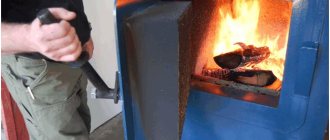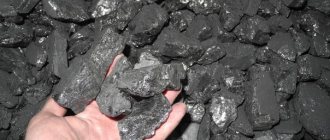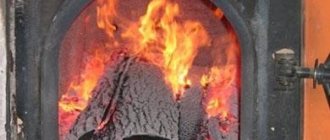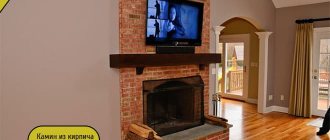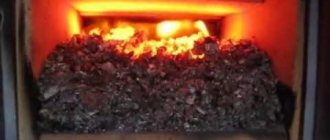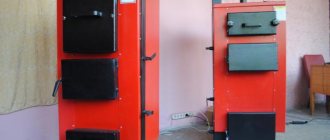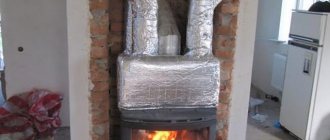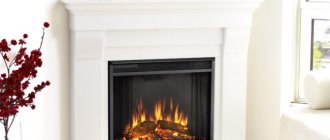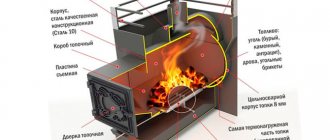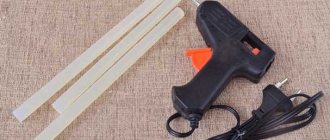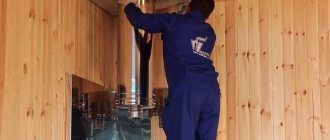The topic of “smokeless” kindling never loses its relevance. With the advent of metal stoves, many owners of summer houses and houses in the private sector are choosing this heating option. The main advantage of air stove heating is low capital costs. And if you choose a fireplace stove that is more efficient, then another problem will be added to the problem of smoke getting into the room - soot on the glass. It settles quickly and is difficult and unpleasant to remove.
Below we will talk about how to light a fireplace stove so that it does not smoke. We will consider two different ignition methods, in which the products of fuel combustion will completely escape through the chimney to the street, as well as preparing the equipment for operation.
What is a fireplace stove?
The appearance of fireplace stoves on the heating appliance market has become a real boon for summer residents and owners of temporary residences. Previously, they had to choose between fast warm-up and high efficiency. An open fireplace, which in a few minutes turns the glacier into a comfortable room for living, is very voracious. Firing with wood requires a lot of attention: if you miss the time of the next bookmark, the fire will go out and the room will cool down as quickly as it warmed up. The efficiency of most modern stoves exceeds 50%, and the intensity of fuel combustion in them is well regulated. But the fast warm-up mode can not be configured on all models.
The fireplace stove is a hybrid heating unit that does not have these disadvantages. The intense combustion of the first bookmark allows you to quickly deliver a large amount of heat into the room. After additional loading, the fireplace stove can be switched to a long-burning mode, maintaining heat release at a level that compensates for heat loss.
The main differences in the design of this unit from a traditional fireplace:
- glass door equipped with a locking mechanism that ensures a tight fit;
- flame breaker - a metal plate that changes the direction of movement of exhaust gases, that is, it organizes smoke circulation.
The main difference from a traditional chimney stove is its lighter weight, which does not require installation on a foundation. At the same time, the design of the fireplace stove retains the blower door and smoke channel damper. Many models are equipped with functions for supplying secondary and tertiary air and self-cleaning glass.
Firewood for an open structure
When choosing how to heat an open fireplace, you need to take into account that the smell of burning material enters the room. Therefore, tree species with a high content of resins in their composition are not suitable. But you can add a little pine needles for a pleasant aroma.
Alder firewood is considered to be of good quality. It is easy to determine ownership by the orange color of the wood. In tsarist times, alder was used to quickly warm up the bathhouse. High heat transfer, pleasant smell and virtually no smoke characterize alder firewood.
Birch wood is more common and less expensive. If you peel off the bark, the smoke emission during combustion will be insignificant. And birch bark is great for lighting a fireplace. If you constantly heat your house with birch, then it is advisable to clean the chimney every month. The event provides good traction during kindling.
A pleasant aroma appears in the room when using wood from fruit trees. To fill the room with a healing scent, branches of garden trees left after pruning are used. The raw materials must be thoroughly dried.
Aspen wood provides beautiful combustion with low heat release. It is recommended to fire the fireplace with aspen raw materials several times a season to clean the chimney of excess soot.
Necessary accessories
You need to prepare for the first kindling in your life. There are a few seemingly insignificant things that should be on hand when you start lighting a fireplace in your home:
- Poker . It needs to reach the back wall and the far corners of the firebox, then it will be comfortable for her to work.
- Scoop . It should be light, non-flammable, and fit across the width of the ash drawer door. When choosing, pay attention to metal scoops: they meet all the requirements.
- Canvas mittens . The fire door handle, poker and scoop can become very hot. Canvas mittens will protect your skin from burns and are comfortable to work in. Cloth vachegs, for example, are significantly inferior to them in terms of comfort. They are convenient for holding a thick crowbar, but not a poker.
Safety first
Simple rules for using a fireplace allow you to make it not only a source of comfort in the interior of your apartment, but also a safety zone.
- For kindling, it is prohibited to use flammable liquids that are not intended for this purpose - gasoline, alcohol, acetone, etc.
- It is prohibited to burn coal or other unintended fuels in wood-burning fireplaces.
- Many modern fireplaces are equipped with special protective screens that prevent sparks and coals from flying out. If there is no such screen or the fireplace is intended to be operated with an open screen, all flammable objects (carpets, furniture) must be moved to the maximum distance.
- To avoid burns, servicing a burning fireplace must be done using protective gloves and special metal tools.
- The fireplace door should be opened smoothly to avoid creating too much draft and causing burns.
- An open fire should not be left unattended unless absolutely necessary, so lighting the fireplace should be planned taking into account all possible absences.
- The fire should not be extinguished by force. You need to wait until the wood burns itself.
- The view damper can only be closed an hour or two after the coals have completely died out.
- The chimney must be periodically cleaned of soot to prevent it from igniting.
Compliance with these basic requirements allows you to ensure the safe operation of the fireplace, maximize its service life, maintain the functionality of the heating structure and preserve its appearance.
A fireplace is not only a decorative element, widely used in modern interior designs, but also a source of heat obtained by burning wood. The choice of fuel for lighting a fireplace affects the efficiency of its operation, as well as its appearance. Therefore, the decision about which firewood is best for the fireplace will determine the service life and appearance of the firebox after several ignitions.
Chimney inspection
A chimney clogged with soot will never have good draft. Soot and tar on the internal surfaces reduce the flow area of the pipe and prevent the free movement of flue gases. After the furnace has been idle for a long time, moisture accumulates in the loose soot, and draft will not be established until it has completely evaporated. In addition, such deposits often lead to a fire inside the chimney, which is almost impossible to extinguish. Therefore, before lighting the fireplace, you need to make sure that the chimney is ready for use.
If the pipe is straight, you can use a mirror to inspect it. If it changes its direction, then there should be an inspection hatch at the turning point. It is also necessary to ensure the integrity of the chimney - there are no cracks at the joints.
The chimney should be cleaned before and during the heating season. The most effective way to remove deposits is mechanical. A brush that matches the diameter of the pipe will remove all dirt from the inner walls.
Preparing the firebox
The algorithm for preparing fireboxes is the same for all solid fuel heating devices:
- We take out everything that can be taken out: the “armor”, the grate, the ash drawer.
- We inspect the surfaces for cracks, burns and contamination.
- We make sure that the smoke damper, the secondary air supply damper, the hinges and locks of the glass door are working, and we check the tightness of the latter.
- We clean all accessible surfaces using a scraper and brush, and remove the ash.
Most manufacturers of metal stoves and fireplace stoves recommend calling service specialists to inspect the stove and chimney before the start of the heating season.
Checking traction
If the flame of a lit match or splinter deviates towards the exit of the flue gases, everything is in order with the draft. Otherwise, it will have to be stabilized, otherwise it will not be possible to light a fireplace without smoke. Natural draft depends on many factors, including the strength and direction of the wind, atmospheric pressure, humidity and others. But we can influence only one of them - the difference in temperature outside and inside the chimney.
If the room where the fireplace is located is warmer than outside, problems usually do not arise. There is already a temperature difference. Otherwise, we recommend using one of the following tips:
- Use a hair dryer. To do this, you need to cut a plywood panel that will completely cover the firebox opening, and make a hole in it the same size as the hair dryer nozzle. A stream of hot air will quickly warm up the firebox and remove the so-called air lock from the chimney.
- Open the chimney inspection hatch and burn several bundles of newspaper in it. You can also heat the chimney through the firebox. You need to bring the torch as close as possible to the outlet pipe.
- Place a burning candle in the firebox, close the firebox door and open the vent slightly. Warming up will take about half an hour.
One of the conditions for stable draft is normal supply ventilation. The room where the fireplace stove is installed should not be tightly sealed.
Types of smoke
It turns out that a fireplace can smoke in different ways. By the type of smoke you can quickly find possible causes, so first of all we will try to provide a classification that will make it easy to correct the current situation.
- The reason why wisps of smoke enter the room is the reverse draft. This is a phenomenon in which gases move in the opposite direction. Various types of disturbances in the functioning of the structure lead to reverse draft, but there is only one global reason - the pressure in the room is lower than the pressure outside.
- A change in the direction of draft (overturning) is characterized by the fact that, under the influence of the determining factor, a local emission of smoke from the firebox occurs. This factor could be the opening of a window or door. Usually, when the cause is eliminated, the draft in the fireplace returns to normal.
- Often there are no complaints about the operation of the fireplace, but when kindling the smoke in the room it is impossible to avoid. This group of smoke includes situations where a similar phenomenon is observed when adding firewood to the firebox.
- A separate group includes cases where even the high temperature of the fireplace does not help. During operation, smoke comes from the firebox; it flows from corners and crevices without ceasing.
Something definitely went wrong
Preparing fuel
Most fireplace stoves are designed to burn wood. But there are also models that can operate on coal and fuel briquettes. In any case, you will have to light the fireplace stove with wood, and switch to the “main” fuel from the second bookmark. And for this they need to be properly prepared:
- Trees are cut down in late autumn or winter, when the flow of sap stops.
- Pay attention to the depth of the firebox: finished firewood should not protrude outward. The maximum log length for a factory stove-fireplace is indicated by the manufacturer in the user manual. The logs are cut to this size.
- To achieve the required humidity, the logs are split and stored under a canopy until the next heating season.
- The firewood is dried indoors. This may take from 1 to 3 days (depending on outdoor storage conditions).
If the residual moisture content of the wood is more than 20%, lighting the fireplace without smoke will be problematic. In addition, evaporating water will condense on the internal stacks of the chimney and cause soot to settle.
What should I choose for the new model?
For such models, it is necessary to take care of the flooring - the stench can easily penetrate into the middle of the firebox and does not interfere with the closing of the doors. It is important to avoid choosing on hard rocks, as the stench will burn out longer. The best choice is clear, linden, pine or poplar, but remember that the remaining heat transfer is insignificant, so it is impossible to fully heat it.
What type of firewood is best for a fireplace? The homeowner rules independently, but there is a hidden rule: you must use the same burning agent as is supplied to the device and is prescribed in the manufacturer’s instructions.
Lighting up a fireplace stove in the classic way
Lighting the stove in the classical way implies the spread of combustion from the bottom (from the grate) to the top. The first filling is carried out in the following order:
- a lump of crumpled paper or a mound of birch bark;
- thin chips with a diameter of up to 1 cm;
- small logs (up to 3 cm).
The wood is not laid too tightly so that air can flow freely into the gaps. To light a fireplace without smoking, it is important not to overload the firebox. The first tab should occupy about 10% of its volume. After the paper catches fire, you need to carefully (without slamming) close the fireplace door. In this case, the vent should be slightly open.
Firewood of regular thickness is laid after the wood chips have completely burned out. There should be hot coals with some flame left. An attempt to lay thick logs immediately often leads to the fact that the combustion products of the paper cool down and do not have time to heat the wood chips to the ignition temperature. This is accompanied by intense smoke and sometimes stalling of the draft. Often massive logs located on top sag and disrupt the structure of the bookmark.
Safety first
Simple rules for using a fireplace allow you to make it not only a source of comfort in the interior of your apartment, but also a safety zone.
- For kindling, it is prohibited to use flammable liquids that are not intended for this purpose - gasoline, alcohol, acetone, etc.
- It is prohibited to burn coal or other unintended fuels in wood-burning fireplaces.
- Many modern fireplaces are equipped with special protective screens that prevent sparks and coals from flying out. If there is no such screen or the fireplace is intended to be operated with an open screen, all flammable objects (carpets, furniture) must be moved to the maximum distance.
- To avoid burns, servicing a burning fireplace must be done using protective gloves and special metal tools.
- The fireplace door should be opened smoothly to avoid creating too much draft and causing burns.
- An open fire should not be left unattended unless absolutely necessary, so lighting the fireplace should be planned taking into account all possible absences.
- The fire should not be extinguished by force. You need to wait until the wood burns itself.
- The view damper can only be closed an hour or two after the coals have completely died out.
- The chimney must be periodically cleaned of soot to prevent it from igniting.
Compliance with these basic requirements allows you to ensure the safe operation of the fireplace, maximize its service life, maintain the functionality of the heating structure and preserve its appearance.
Top burning kindling
There is an alternative way of stacking firewood to light a fireplace, in which combustion occurs from top to bottom. The stacking begins with the thickest logs, wood chips are placed on top, then birch bark and paper. With this method, the firebox can be filled approximately 2/3 full. Even if the stove is cold and the draft is uncertain, the paper, which is located almost at the very outlet pipe, will warm up the chimney.
A prerequisite for starting kindling is that the ash pan must be tightly closed so that combustion air flows through the open opening of the fuel channel. When the draft stabilizes, you can open the blower and lock the glass door. After the bookmark burns out, a new portion of firewood is loaded. The fireplace stove is already warm enough. Therefore, if the room also becomes warm, it can be switched to long-burning mode.
To clearly demonstrate how to properly light a fireplace without smoke with an alternative stacking of firewood, we recorded a video that shows in detail all the nuances of this method. You can ask any questions you are interested in in the comments to the video by subscribing to our channel on YouTubeFornaksFilm
Safety precautions
A little higher, we said that when lighting a fireplace, it is undesirable to use various means of ignition. Unlike a fire or barbecue, where the flame goes up in any case, here it is limited by the walls. When there is a flash, the fire will go in the open direction - that is, in the face. For the same reason, you cannot use simple matches - only special ones, fireplace ones, whose length is from 15 to 25 cm. Stir the coals only with a poker or tongs.
Much more important is the cleanliness of the chimney, the position of the view and the blower. They are responsible for the proper removal of smoke and carbon dioxide generated during combustion. While open flames and smoke can be seen with the naked eye, CO2 cannot be seen or smelled. We strongly recommend that you check the smoke system before each use and do not light the fireplace if you have any doubts about the safety of the process.
